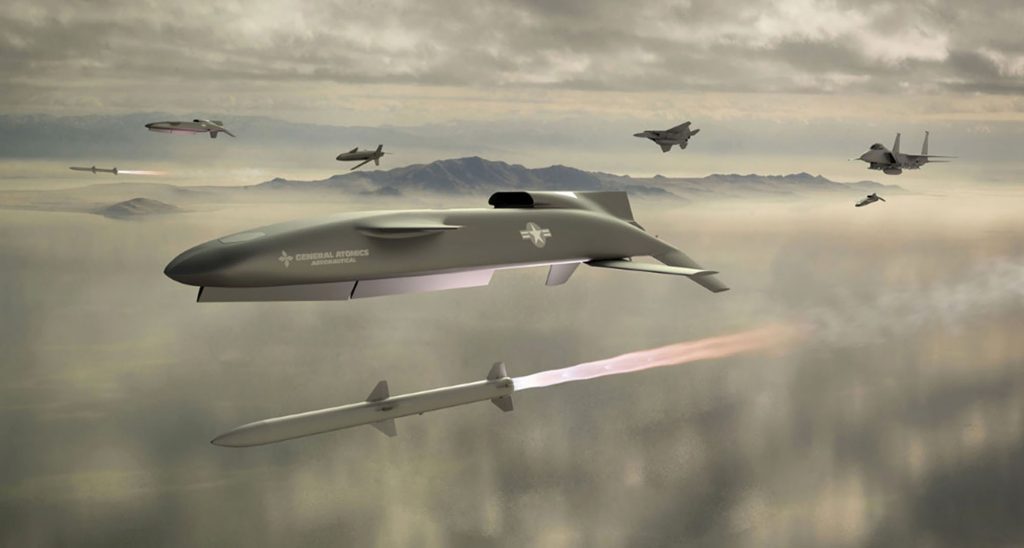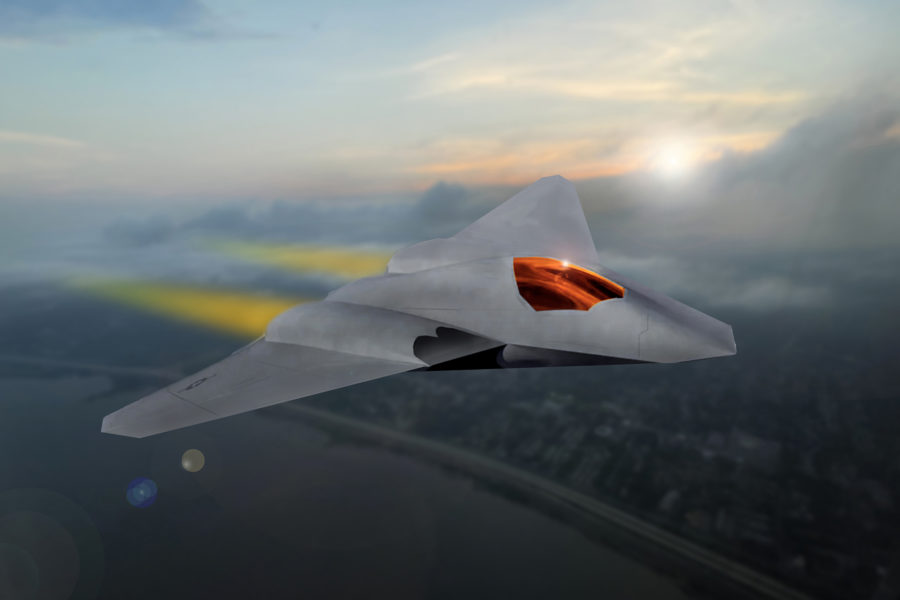The Air Force plans to dramatically ramp up spending on the Next Generation Air Dominance fighter program in the coming years, to the tune of $28.48 billion fiscal 2025-29, according to newly released budget documents. That figure includes the Collaborative Combat Aircraft program, which will produce uncrewed, semi-autonomous “escort” aircraft to fly alongside NGAD.
The NGAD is the Air Force’s highest-priority air dominance program and is slated to replace the F-22 beginning around 2030. It’s characterized as a “family of systems,” which includes CCAs, of which Air Force Secretary Frank Kendall has said the service will build at least 1,000 units, with the first ones ready for combat in 2028.
No official buy objective for NGAD has ever been stated, but service leaders have hinted at fleet sizes in the 200-250 range. Kendall has also said the crewed NGAD will cost in the “multiple hundreds of millions” of dollars per aircraft. The first increment of CCA drones are expected to cost around $30 million each.
The crewed aircraft at the center of the NGAD formation is expected to be an ultra-stealthy platform, escorted or aided by CCAs that will perform sensing, jamming, communications relay, and targeting functions. They will also carry additional munitions that can be aimed by the one pilot in the formation or attack targets on their own. Air Force leaders have said there may be two variants of the NGAD: one for the European theater and a longer-range version optimized for the Pacific theater.
The Air Force expects to award development contracts this year to two companies for NGAD and three for CCA.
In 2025, the service is asking for nearly $2.75 billion for NGAD, a leap of $1.2 billion over the amount requested in the fiscal 2024 budget request, which has not yet been approved by Congress. The CCA program is budgeted for around $577 million, an increase of $170 million over 2024.
Over the future years defense plan (2025-29), the Air Force is planning $19.6 billion in research, development, test, and evaluation for NGAD alone, on top of $8.9 billion for just CCA.
| Segment | 2025 | 2026 | 2027 | 2028 | 2029 |
|---|---|---|---|---|---|
| Total NGAD program element | $3.306 billion | $3.684 billion | $5.396 billion | $7.247 billion | $8.289 billion |
| NGAD only | $2.749 billion | $3.189 billion | $3.742 billion | $4.201 billion | $5.723 billion |
| CCA only | $577.1 million | $494.9 million | $1.654 billion | $3.046 billion | $3.106 billion |
Although CCA drones are set to be operational as early as 2028, and the NGAD circa 2030, no procurement or long-lead funding for production was specified in the Air Force procurement budget request. A service official said this was likely due to operational secrecy concerns.
The Air Force is also asking for $300 million over the FYDP for the Autonomous Collaborative Program, in which it will explore manned-unmanned teaming, swarm tactics, and collaboration among CCAs. That funding line rises steadily from $51 million in 2025 to $65.2 million in 2029.
The Air Force’s RDT&E budget justification documents say that after a contractor is picked for NGAD engineering and manufacturing development, activities will include building an open-architecture framework for mission systems and “design, build and test of” of an all-up weapon systems, including “development, integration, test and building demonstrative prototypes.”
The program will “continue to conduct analyses, identify technology candidates and perform concept refinements,” and there will be fabrication of “spectral dominance platforms,” suggesting an uncrewed electronic warfare escort for the platform.
“Additional details … cannot be provided at this classification level,” the documents note.
For CCA, the fiscal 2025 plan calls for further analysis to “identify technology candidates, perform concept refinement studies, development, integration, test, prototyping, and demonstrations, as well as crewed systems integration to reduce risk and mature CCA concepts and air superiority related technologies in support of the NGAD.”

The NGAD figures don’t include the Next Generation Adaptive Propulsion (NGAP) program, which will develop new engines for the NGAD that will provide improvements in acceleration and range over the F-35’s F135 engine. The NGAP will derive from the Adaptive Engine Transition Program (AETP), in which GE Aerospace and Raytheon’s Pratt & Whitney developed engines that could fit the F-35 and provide increased thrust and range. That program was abandoned because it could not benefit users of F-35B short takeoff/vertical landing variants, and because the AIr Force could not afford to develop the engine for its F-35As on its own.
The NGAD line items also don’t include new weapons being developed for it, to include the AIM-260 Joint Advanced Tactical Missile (JATM).
The Air Force quoted slightly different figures for NGAD and CCA in its budget briefing charts than in its justification books, saying in the charts that the NGAD overall line item is $3.390 billion for 2025, of which $2.831 billion is for the NGAD platform and $559 million is for CCA. It also said it is investing $116 billion “across several other program elements for CCA autonomy testing and non-material solutions, totaling $675 [million] toward CCA development.”
A service spokesperson could not immediately explain the discrepancy but suggested that the charts included elements of some related technology efforts.
